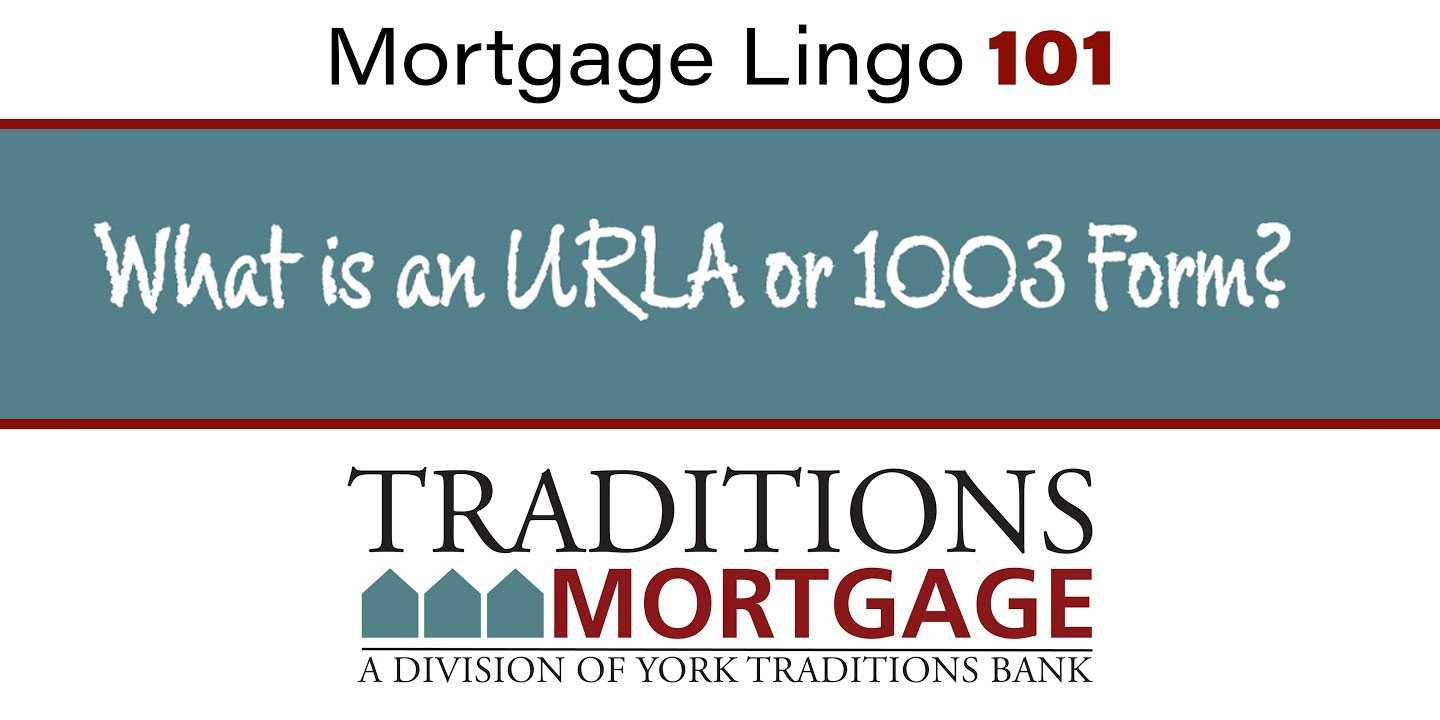In the United States, the standard form used by most mortgage lenders is the Uniform Residential Loan Application or “URLA,” also known as the 1003 Form. When you apply for a mortgage, you will likely need to complete this form.
All of those letters and numbers aren’t as confusing as you think! At Traditions Mortgage, we strive to educate our referral partners and customers on the mortgage process, along with mortgage lingo. As a result, we established this six-week-long video series to explain some of the more frequently used mortgage terms.
In this video, we talk about the 1003 Form or URLA.
What is a 1003 Form?
You may hear this term used by a mortgage professional when they say, “Please sign the 1003 Form,” or, “Your income is listed on page 2 of the 1003 Form.”
The 1003 Form is Fannie Mae’s form number for the Uniform Residential Loan Application (URLA). Freddie Mac refers to this as Form 65. The URLA, 1003, and Form 65 are all the same forms and serve as a mortgage loan application. The Uniform Residential Loan Application is currently a multi-page document that collects the essential information for processing your mortgage application. It details the loan terms and information about the borrower, such as income, employment, assets, and expenses. It also requests information that the U.S. government regulates.
How is the 1003 Form used?
Lenders in the U.S. use the 1003 Form to evaluate potential applicants, including borrowers seeking refinances, construction-to-permanent loans, conventional loans, VA, FHA, and USDA mortgage loans.
The new 1003 Form offers benefits to both borrowers and lenders. For borrowers, the 1003 Form is easy to complete and review, making applying for a mortgage simpler. For lenders, the data that is collected is more relevant, reliable, and flexible.
Lenders need to use the 1003 Form to ensure their mortgage loans align with Fannie Mae and Freddie Mac’s rules and guidelines. Fannie Mae and Freddie Mac buy mortgage loans in bulk from lenders, and using this form helps confirm that the loans qualify for resale…
How is the 1003 Form used?
Recently, the 1003 Form was redesigned and updated. As of March 1, 2021, lenders have begun using this new form. Make sure you are completing the most recent version of the document.
Here are some of the recent changes for the 1003 Form:
- Font sizes increased
- Easier to read and understand
- New sections
- More clarity on sections within the form
- A similar appearance to other mortgage documents
- Easier notations if sections do not apply to specific applicants
- Non-standard response elimination with drop-down lists of most likely choices
- One-borrower form design, meaning there are no more double columns
Fannie Mae updated the form to capture the information needed while making the loan application easier to complete and process online.
Components of the 1003 Form
There are nine sections in the 1003 Form. These include:
- Section 1: Borrower Information
- Section 2: Financial Information (Assets and Liabilities)
- Section 3: Financial Information (Real Estate)
- Section 4: Loan and Property Information
- Section 5: Declarations
- Section 6: Acknowledgements and Agreements
- Section 7: Military Service
- Section 8: Demographic Information
- Section 9: Loan Originator Information
The components on loan originator information and borrower information are used with every loan. In contrast, new elements such as the continuation sheet, additional borrower information page, and unmarried borrower addendum are used as needed.
Steps for Filling Out a 1003 Form
You will need to provide specific documentation to fill out a 1003 Form, such as:
- Income: Include all taxable income sources, including regular pay, commissions, and any other sources you may have.
- Employment information: Make sure you have your employer’s name, address, and phone number. You will also need your position title and the number of years you’ve worked for this employer. You may be asked for your previous employment history.
- Demographic data: You will have the option to provide your demographic information, such as your race, ethnicity, and gender.
- Borrower information: You will need to provide your name, date of birth, Social Security number, phone number, address, and marital status. You may also need to provide your resident status and citizenship. If there is a co-borrower, they will need to provide this as well.
- Property information: Ensure you have all available information on the property, including the address, the intended property use, and the home’s age. If you are applying to purchase a home, you will need to provide the purchase price.
- Housing expenses: This may include your monthly rent, real estate taxes if you own a home, and other potential expenditures.
- Assets and debts: You will need to provide information on your assets and debts. Assets include your savings and checking account balances, retirement accounts, bonds, stocks, real estate, etc. Debts can include vehicle loans, credit card balances, student loans, and other monthly payments.
Your lender will be happy to assist you in completing this form, so don’t worry if you have any questions or concerns or you’re uncertain about a section. When you complete this form, the lender will use it to determine whether you are a good candidate for a mortgage loan.
Make sure you fill out the form to the best of your ability and as accurately as possible before signing the application. If you find any mistakes, ask your lender to correct those before you sign and submit your 1003 for consideration.
Contact Traditions Mortgage
At Traditions Mortgage, we serve our communities because we live here too. We’re proud to make decisions locally. We are committed to providing our customers with solutions to help them achieve prosperity and growth. Our mortgage team will help you through the home buying process, from application to underwriting to closing. For more information, contact us today!
For more information, contact a member of our Traditions Mortgage team today!
